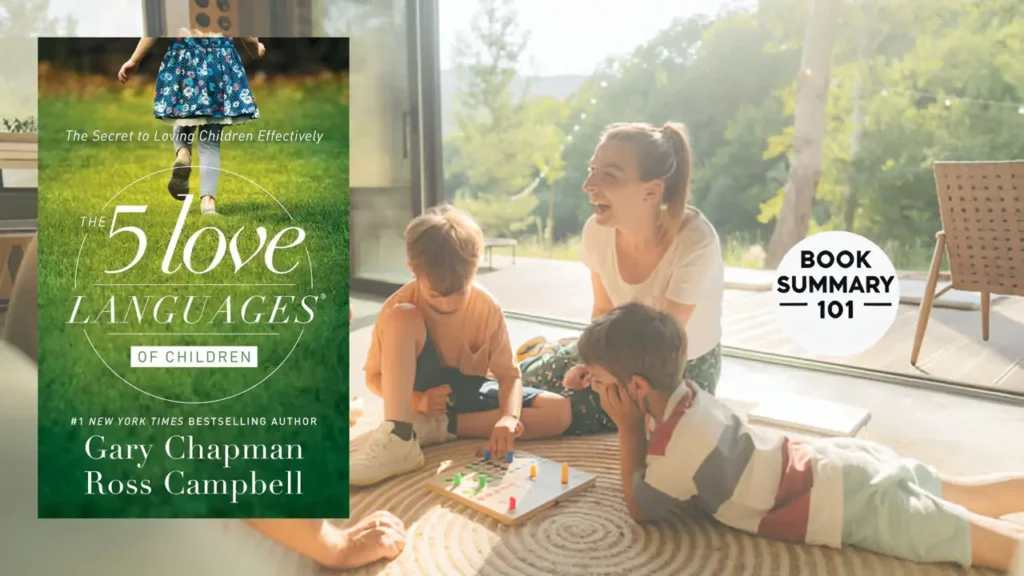Have you ever felt like your words and actions aren’t quite reaching your child’s heart? Maybe you’re doing all the “right” things, yet your child doesn’t seem to feel loved in the way you’d hoped. That’s where The 5 Love Languages of Children by Dr. Gary Chapman and Dr. Ross Campbell comes in. The book is a parenting guide with a simple but powerful message: each child has a unique “love language” that speaks to their heart more directly than others.
By learning these love languages, you can show love in ways that resonate with your child, deepening your bond and helping them grow into emotionally secure individuals. Let’s dive into each of these love languages in detail—and explore how knowing them can revolutionize the way you connect with your kids.
The book on amazon 👉 The 5 Love Languages of Children 📚
The 5 Love Languages of Children
Each love language represents a different way a child can feel loved and valued. Here’s a closer look at each one, with practical tips to help you speak your child’s unique language.
1. Words of Affirmation
For some kids, words really do speak louder than actions. Children who need words of affirmation thrive on positive reinforcement and genuine praise. They crave kind, encouraging words that make them feel seen and appreciated. These words help them understand their value, and they go a long way in building self-esteem.
Real-Life Example: Imagine your child comes home with a handmade drawing, clearly proud of their work. A simple “Wow, this is beautiful!” or “I love how you used all those colors!” makes them feel valued. Dr. Chapman shares about a young boy named Tom who transformed when his dad began giving more specific praise for his efforts. Rather than a general “Good job,” Tom’s dad would say things like, “You put so much effort into this – I’m really impressed by your hard work!” That shift made Tom feel truly seen and encouraged.
How to Use This Language: Make it a habit to give your child specific praise that highlights their strengths and efforts. You might say, “I’m so proud of how you helped your friend,” or “I love how you kept trying even when it was hard.” Leave little notes in their lunchbox, whisper “I love you” at bedtime, or simply make eye contact when you say something nice. These little moments add up to make your child feel loved and seen.
2. Quality Time
Some children value undivided attention above all else. For these kids, it’s not just being near you that matters—it’s having your full, focused attention. Quality time gives children the message that they’re important, valued, and worth your undivided attention.
Real-Life Example: Dr. Chapman shares the story of a girl named Emma who constantly acted out at home. Her parents later realized that Emma’s primary love language was quality time, but they had been too busy to give her their undivided attention. Once they made time to be with her—just the two of them—Emma’s behavior improved drastically. She felt more connected and secure because her parents were filling her “love tank” with quality time.
How to Use This Language: Set aside time each day (even if it’s just 10 minutes) to spend one-on-one with your child. It can be a bedtime ritual, cooking together, or going on an outing. The key is to focus fully on them, putting away all distractions like your phone or to-do list. Kids notice when you’re “there but not there,” so make eye contact, ask questions, and listen actively. These special moments can become cherished memories and help your child feel truly connected to you.
3. Receiving Gifts
While every child loves receiving gifts, some children feel particularly loved when they receive a thoughtful present. For these kids, a gift isn’t just a material object; it’s a tangible reminder of your love. The best gifts for children with this love language are personal, meaningful, and given with thoughtfulness rather than extravagance.
Real-Life Example: A child named Ben loved receiving little trinkets or tokens from his parents. They didn’t have to be expensive – in fact, his most treasured gift was a small, painted rock his mom found during a hike. For Ben, this rock was a reminder that his mom thought of him even when they weren’t together. It became a comfort object that he kept by his bedside.
How to Use This Language: Find simple, thoughtful ways to give gifts that show you’ve been thinking of them. For example, pick up a unique leaf on your way home from a walk or make a small craft they can cherish. Consider giving them “experience gifts” as well, like a day at the zoo or a special outing. It’s the thoughtfulness and personal touch that makes the gift special—not the price tag.
4. Acts of Service
For some children, actions speak louder than words. Acts of service are all about demonstrating your love by doing things for your child, especially when it helps or supports them. This might be fixing a toy, helping with homework, or doing something special just for them. These children feel valued when their needs are met with care and support.
Real-Life Example: Dr. Chapman talks about Sophie, who often struggled with her homework. Although her parents encouraged her verbally, she felt most loved when they took the time to sit down and help her with her assignments. This act of service made her feel supported, and it strengthened their bond. With her parents’ help, she was able to complete her work and feel successful.
How to Use This Language: Look for ways to assist or support your child, especially when they’re struggling or feeling down. It might be as simple as cooking their favorite meal or spending extra time with them on a challenging task. Be careful not to overdo it, as too much help can prevent them from building independence. Instead, offer your support in a balanced way that shows you’re there for them.
5. Physical Touch
Children who value physical touch need regular, warm contact to feel safe and loved. Hugs, kisses, and gentle physical play all communicate love and comfort to them. Physical touch creates a sense of security, especially when a child is feeling upset, anxious, or overwhelmed.
Real-Life Example: Lucas was a young boy who had a tendency to become withdrawn and anxious, especially at bedtime. His parents learned that physical touch was his primary love language. They started a nightly routine of cuddling for a few minutes before he went to sleep, and this simple act of closeness helped him feel more secure, eventually easing his anxiety.
How to Use This Language: If your child’s love language is physical touch, incorporate it into your daily interactions. Give hugs, hold hands, ruffle their hair, or cuddle on the couch. Physical play can also be a great way to connect—try wrestling or playing catch if your child enjoys that kind of interaction. During moments of distress, a hug or handhold can be even more powerful than words.
Why Read This Book?
The 5 Love Languages of Children isn’t just another parenting guide—it’s a tool for creating meaningful, lifelong connections with your kids. Understanding your child’s love language helps you reach them in ways that make a lasting impact on their emotional development. When you’re speaking their love language, your child feels truly seen, understood, and cherished, which can improve behavior, increase self-confidence, and lay the foundation for a healthy parent-child relationship.
For parents with more than one child, the book is also invaluable. Chapman explains that siblings often have different love languages, and using a one-size-fits-all approach may not be effective. Learning to tailor your approach to each child’s needs can prevent sibling rivalry and create harmony in the home.
Join the Conversation!
Have you tried using love languages with your child? Which love language do they connect with most? Whether you’ve already read the book or are considering it, we’d love to hear your thoughts! Share your experiences and tips on connecting with your child, and let’s support each other on this journey of parenting.
Unlocking your child’s heart starts with knowing how they need to be loved. Let’s make each moment count.
The book on amazon 👉 The 5 Love Languages of Children 📚
5 quotes from The 5 Love Languages of Children:
1. “Every child has an emotional tank, a place of emotional strength that can fuel them through the challenging days of childhood and adolescence.”
➡️ This quote reminds us that love isn’t just a feeling—it’s fuel. When a child’s “love tank” is full, they’re more resilient, confident, and capable of handling life’s ups and downs.
2. “Children who feel loved unconditionally are more likely to obey and cooperate with their parents.”
➡️ Discipline becomes easier when love is the foundation. Kids don’t just need correction—they need connection.
3. “The best thing you can do for your child is to love them in a way they can understand and receive.”
➡️ You may feel like you’re showing love, but the real question is: are they feeling it? This quote is the heart of the love languages concept.
4. “When a child misbehaves, they may not be acting out of defiance—but out of a desperate need to feel loved.”
➡️ Sometimes, behind every tantrum or withdrawal is a love tank running low. This shifts the way we see our children’s behavior—it’s often communication in disguise.
5. “A hug, a smile, a kind word, or a small gift can speak volumes to a child when it aligns with their love language.”
➡️ Love doesn’t have to be grand or complicated. The little things, when they’re the right things, make the biggest impact.


